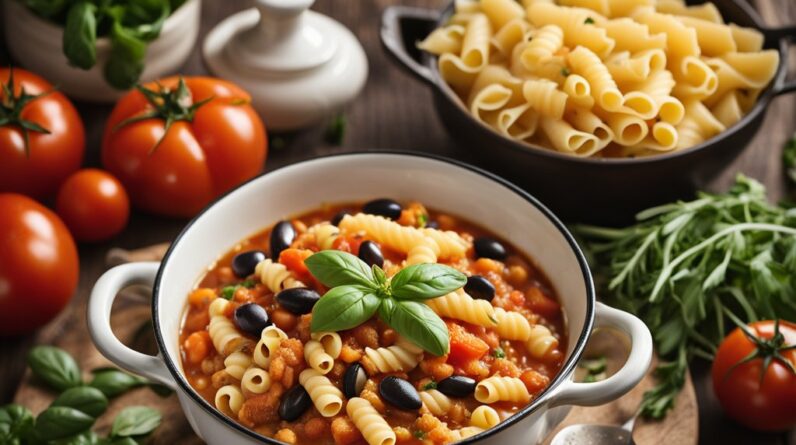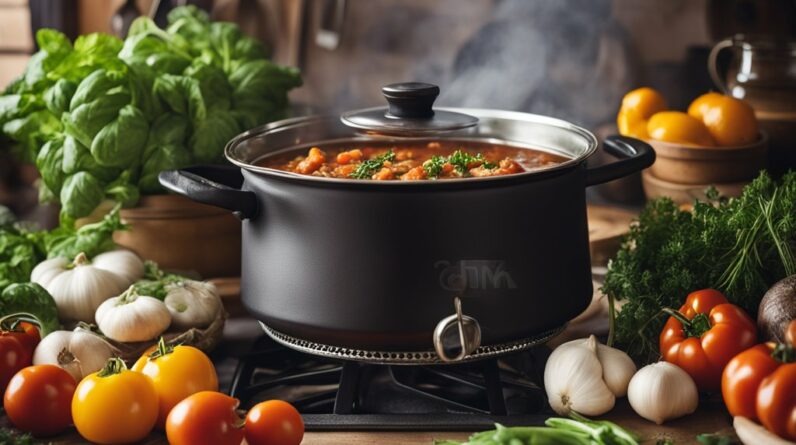In our quest to recreate the delicious tastes of Italy, we often find ourselves wondering: what’s the secret behind achieving those authentic flavors in Italian recipes? From the perfectly balanced pasta sauces to the mouthwatering pizza toppings, there is a certain allure to Italian cuisine that leaves us craving for more. In this article, we’ll uncover the key element that brings that unmistakable taste to your favorite Italian dishes, and share some tips to help you master it in your own kitchen. Get ready to unlock the secret behind those mouthwatering flavors!

Using Fresh, Quality Ingredients
Selecting Local Produce
One of the key ingredients to achieving authentic flavors in Italian recipes is using fresh, quality ingredients. We believe in the importance of supporting local farmers and selecting locally sourced produce. By choosing local produce, we ensure that our ingredients are at the peak of freshness and flavor. Not only does this support local communities and reduce our carbon footprint, but it also guarantees that we are using ingredients that are grown specifically for our region’s climate and soil conditions. When our ingredients come from nearby farms, they spend less time in transit, preserving their flavor and nutritional value.
Using Seasonal Ingredients
Another aspect of using fresh, quality ingredients is incorporating seasonal produce into our recipes. Seasonal ingredients are not only more flavorful, but they are also more affordable and environmentally friendly. The flavors of seasonal fruits and vegetables are at their best, being naturally ripe and vibrant. By embracing the seasons, we can make the most of the produce available to us and create dishes that are in harmony with nature’s offerings. From summery tomatoes and basil to hearty winter root vegetables, each season brings a unique variety of ingredients to inspire our recipes.
Opting for Organic Ingredients
In our pursuit of authentic flavors, we also place great importance on using organic ingredients whenever possible. Organic produce is grown without the use of synthetic pesticides, genetically modified organisms (GMOs), or artificial fertilizers. By choosing organic, we support sustainable farming practices that prioritize the health of the soil, water, and ecosystems. Organic ingredients also tend to have a more intense and pure flavor due to their natural cultivation methods. We believe that by opting for organic ingredients, we can create dishes that not only taste delicious but also contribute to a healthier planet.
Choosing High-Quality Meats and Cheeses
While Italian cuisine is renowned for its focus on fresh produce, high-quality meats and cheeses also play a significant role in achieving authentic flavors. We believe in sourcing meats from humanely raised animals that are fed a natural, well-balanced diet. This not only ensures that the animals have led a healthy life but also results in tender and flavorful cuts of meat. By selecting high-quality cheeses, we can appreciate the rich and diverse flavors that different regions of Italy have to offer. From creamy mozzarella to aged Parmigiano-Reggiano, the quality of the cheese enhances the overall taste and authenticity of our Italian dishes.
Mastering Traditional Cooking Techniques
Learning the Art of Pasta Making
One of the most iconic elements of Italian cuisine is pasta, and mastering the art of pasta making is essential for achieving authentic flavors. We knead and roll our pasta dough by hand, allowing us to have control over the texture and thickness of the noodles. Whether it’s creating delicate strands of spaghetti, comforting pillows of gnocchi, or intricate shapes like farfalle or fusilli, the process of making fresh pasta is a labor of love. The texture and taste of homemade pasta are unmatched, creating a foundation for delicious Italian dishes.
Perfecting Homemade Pizza Dough
Pizza is another Italian classic that requires skill and attention to detail to achieve authentic flavors. We take pride in perfecting our homemade pizza dough, using a combination of flour, water, yeast, and salt. The dough is left to rise slowly, allowing the flavors to develop and the gluten to relax, resulting in a light and airy crust. We also understand the importance of a hot and properly preheated oven to achieve the coveted crispy yet chewy texture. By mastering the techniques of pizza dough, we can create a canvas for a variety of toppings and flavors that highlight the essence of Italian cuisine.
Mastering Risotto Cooking
Risotto is a beloved Italian dish that requires patience and precision to master. We embrace the traditional method of slowly adding hot broth to the rice while constantly stirring. This slow and steady cooking process allows the rice to release its starches, resulting in a creamy and luxurious texture. We understand the importance of using the right kind of rice, such as Arborio or Carnaroli, to achieve the desired consistency. By mastering the art of risotto cooking, we can create dishes that are bursting with flavor and have a velvety mouthfeel.
Understanding the Art of Simmering Sauces
Italian cuisine is known for its rich and flavorful sauces, and understanding the art of simmering is crucial in achieving authentic flavors. We pay close attention to the heat and duration of simmering, allowing the ingredients to meld together and develop complex flavors. Whether it’s a classic marinara sauce, a hearty Bolognese, or a creamy Alfredo sauce, the slow and gentle simmering process intensifies the aromas and enhances the overall taste. By mastering the art of simmering sauces, we can elevate our dishes to new levels of deliciousness.
Mastery of Italian Baking Techniques
Italian baking is a true art form, and mastering these techniques is vital for creating authentic flavors. From flaky pastries to decadent cakes, each region of Italy has its unique baking traditions. We embrace these time-honored techniques, such as making delicate puff pastry from scratch or creating the perfect cannoli shell. Attention to detail, precise measurements, and understanding the balance of flavors are all essential in the world of Italian baking. By achieving mastery in these techniques, we can deliver authentic Italian desserts that delight the senses.

Embracing the Power of Simplicity
Less is More: Minimalism in Italian Cooking
Italian cuisine is renowned for its simplicity, where less is more. We embrace this philosophy and understand that the key to achieving authentic flavors lies in allowing the quality ingredients to shine. By using minimal ingredients and minimal seasoning, we allow the natural flavors to take center stage. While it may seem basic, simplicity is the foundation of Italian cooking, emphasizing the taste and texture of each individual ingredient.
Balancing Flavors with Few Ingredients
In Italian cooking, balancing flavors is of utmost importance, even with just a few ingredients. The combination of sweet, sour, salty, and bitter flavors is carefully calibrated to create a harmonious taste experience. For example, a simple caprese salad balances the sweetness of ripe tomatoes with the creamy richness of mozzarella, the sharpness of basil, and the tang of extra virgin olive oil. The harmony of flavors showcases the essence of Italian cuisine.
Highlighting Fresh Herbs and Spices
Fresh herbs and spices play a crucial role in Italian cooking, adding depth and complexity to dishes. We believe in using fresh herbs like basil, parsley, rosemary, thyme, and oregano to infuse our dishes with vibrant flavors. These herbs are often added towards the end of cooking to maximize their aromatics. Similarly, the judicious use of spices like garlic, chili flakes, and nutmeg adds a layer of warmth and complexity to Italian dishes. By highlighting fresh herbs and spices, we can elevate our recipes and create unforgettable flavors.
Appreciating the Essence of Simple Dishes
Italian cuisine celebrates the essence of simple dishes, allowing the ingredients to speak for themselves. From a humble plate of spaghetti aglio e olio to a classic Margherita pizza, these dishes rely on the quality of the ingredients and the skill in preparation. It is in these simple dishes that we truly appreciate the depth of flavors that Italian cuisine has to offer. By embracing the essence of simplicity, we can savor the true taste of Italy.
Respecting Regional Traditions
Exploring the Cuisines of Different Italian Regions
Italy’s regional cuisines are incredibly diverse, each with its distinct flavors, techniques, and ingredients. We believe in respecting and appreciating the regional traditions that have shaped Italian cuisine into what it is today. From the seafood-focused dishes of the coastal regions to the rustic and hearty fare of the mountainous regions, each area tells a story through its food. By exploring the cuisines of different Italian regions, we expand our culinary horizons and gain a deeper understanding of the country’s rich culinary heritage.
Adapting Authentic Recipes from Specific Areas
When it comes to recreating authentic Italian recipes, we understand the importance of adapting them to specific areas. The ingredients available and the cultural influences differ from region to region, and we respect these variations. For example, a pasta dish from Sicily may feature fresh seafood and bold flavors inspired by Arab and North African influences, while a dish from Emilia-Romagna may be focused on rich and indulgent ingredients like Parmesan cheese and prosciutto. By adapting authentic recipes to specific areas, we pay homage to the diverse culinary traditions of Italy.
Preserving Regional Cooking Styles and Techniques
Preserving regional cooking styles and techniques is essential in maintaining the authenticity of Italian flavors. We value the traditional methods and time-honored practices that have been passed down through generations. From the wood-fired ovens of Naples that produce the perfect pizza crust to the centuries-old techniques of aging Parmigiano-Reggiano cheese, these regional cooking styles contribute to the unique flavors that define Italian cuisine. By preserving these traditions, we ensure that the flavors of Italy remain vibrant and alive.

Honoring Time-Honored Family Recipes
Passing Down Generational Culinary Wisdom
Family recipes are the heart and soul of Italian cooking, and we believe in honoring and preserving these time-honored traditions. These recipes often span generations, with techniques and flavors being passed down from parents and grandparents. By embracing these family recipes, we keep the culinary wisdom of our ancestors alive and pay tribute to the flavors of our heritage. From homemade tomato sauce simmered for hours to secret spice blends that add depth to dishes, these family recipes hold the key to authentic Italian flavors.
Keeping Traditional Family Recipes Alive
In an ever-changing culinary landscape, it is crucial to keep traditional family recipes alive. We value the connection to our roots and recognize the importance of continuing these culinary legacies. Whether it’s a treasured recipe for lasagna or a beloved family dessert, these dishes tell a story and evoke a sense of nostalgia. By cooking these traditional family recipes, we not only savor the flavors of our past but also pass on the heritage to future generations.
Preserving Unique Flavors and Techniques
Unique flavors and techniques are often found in family recipes, representing a specific region or even a particular household. We appreciate the distinctiveness of these flavors and techniques and strive to preserve them. From the way a particular dish is seasoned to the specific cooking method used, every detail contributes to the authentic flavors of these treasured recipes. By preserving the unique flavors and techniques found in family recipes, we honor the individuals who have kept these traditions alive for generations.
Understanding the Role of Extra Virgin Olive Oil
Using High-Quality Extra Virgin Olive Oil
Extra virgin olive oil is a staple in Italian cooking and plays an integral role in achieving authentic flavors. We place great emphasis on using high-quality extra virgin olive oil, which is extracted from the first pressing of olives without using heat or chemicals. This process maintains the natural flavors and aromas of the olives, resulting in oil that is fruity, peppery, and vibrant. By using high-quality extra virgin olive oil, we infuse our dishes with the distinctive taste of Italy and enhance their authenticity.
Exploring the Flavor Profiles of Different Varieties
Extra virgin olive oil comes in a variety of flavors and intensities depending on the type of olives used and the region of production. We explore the flavor profiles of different olive oil varieties, ranging from mild and buttery to robust and peppery. Whether it’s the delicate notes of Ligurian olive oil or the bold and grassy flavors of Tuscan oil, each variety brings its unique character to our dishes. By understanding the flavor profiles of different olive oil varieties, we can choose the perfect oil to enhance the flavors of our recipes.
Balancing Olive Oil in Italian Recipes
Olive oil is not only used as a cooking medium but also as a finishing touch in Italian recipes. We understand the importance of balancing the amount of olive oil used to achieve authentic flavors. Whether it’s lightly drizzling olive oil over a fresh Caprese salad or finishing a pasta dish with a generous splash of oil, each application adds a distinct richness and flavor. By carefully balancing the amount of olive oil in our recipes, we can enhance the taste of our dishes without overpowering other ingredients.
Experimenting with Regional Cheeses
Discovering a Variety of Italian Cheeses
Italian cuisine is renowned for its wide range of cheeses, each with its unique taste and texture. We love to explore the variety of Italian cheeses available and experiment with their flavors. From the tangy and crumbly Pecorino Romano to the creamy and nutty Parmigiano-Reggiano, each cheese brings its distinctive character to our dishes. By discovering a variety of Italian cheeses, we can add depth and richness to our recipes and truly celebrate the art of cheese-making.
Pairing Cheeses with Local Ingredients
We believe in pairing Italian cheeses with local ingredients to create a harmonious combination of flavors. By using regional produce and cheeses from the same area, we maintain the authenticity of the dish and highlight the unique flavors of both ingredients. For example, pairing fresh buffalo mozzarella with locally grown tomatoes creates a classic Caprese salad that perfectly captures the essence of Italian cuisine. By carefully selecting the cheeses and ingredients, we can create unforgettable taste experiences.
Incorporating Traditional Cheese in Italian Dishes
Italian cheeses are not only enjoyed on their own but also play a vital role in Italian dishes. We embrace the tradition of incorporating cheese into our recipes, whether it’s grated over pasta, melted into a sauce, or layered in a lasagna. The unique flavors and textures of Italian cheeses add a richness and depth that elevate our dishes to new heights. By incorporating traditional cheese in Italian dishes, we pay tribute to the flavors that have been cherished for centuries.
Utilizing Aromatic Herbs and Spices
Exploring the Richness of Italian Herbaceous Flavors
The use of aromatic herbs and spices is a cornerstone of Italian cuisine, adding layers of complexity and fragrance to our dishes. We explore the richness of Italian herbaceous flavors, from the bright and fresh notes of basil to the earthy undertones of thyme and rosemary. These herbs not only enhance the taste of our recipes but also create an enticing aroma that captivates our senses. By utilizing aromatic herbs, we infuse our dishes with the essence of Italy.
Balancing Aromatics in Dishes
Italian cooking is all about balance, and this extends to the use of aromatic herbs and spices. We understand the importance of balancing the intensity of different aromatics to achieve authentic flavors. Whether it’s the use of a single herb as the star of the dish or a combination of various herbs and spices, each ingredient must contribute harmoniously to the overall taste. By carefully balancing the aromatics in our dishes, we maintain a delicate equilibrium and create a culinary experience that is truly Italian.
Enhancing Taste with Traditional Italian Spices
In addition to herbs, traditional spices also play a role in Italian cooking, enhancing the taste of our dishes. We explore a range of traditional Italian spices, such as garlic, oregano, red pepper flakes, and nutmeg. These spices add depth and warmth to our recipes, creating layers of flavor that transport us to the kitchens of Italy. By embracing traditional Italian spices, we infuse our dishes with authenticity and capture the essence of Italian cuisine.
Maintaining the Balance of Flavors
Understanding the Importance of Balance
Balancing flavors is essential in Italian cuisine, and we understand the importance of achieving the perfect equilibrium. In every dish we create, we strive to balance the sweetness, acidity, saltiness, and bitterness to achieve authentic flavors. By discerning the right proportions and adjusting seasonings, we ensure that each taste is perfectly calibrated, resulting in a harmonious dining experience. Understanding the importance of balance allows us to create Italian dishes that are satisfying and well-rounded.
Complementing Sweet and Savory Tastes
Italian cuisine is known for its ability to seamlessly combine sweet and savory flavors. We embrace this harmonious pairing and understand how to complement the natural sweetness of ingredients like tomatoes or caramelized onions with savory elements like garlic or Parmesan cheese. By delicately balancing these flavors, we create dishes that are well-rounded, capturing the essence of Italian cuisine. The combination of sweet and savory tastes adds depth and complexity to our recipes, resulting in unforgettable flavors.
Harmonizing Acidity and Creaminess
The balance between acidity and creaminess is crucial in Italian cooking. We understand how to harmonize these elements to create dishes that are both refreshing and indulgent. For example, a classic carbonara sauce combines the richness of eggs, cream, and cheese with the tanginess of freshly squeezed lemon juice. By achieving the perfect balance of acidity and creaminess, we create Italian dishes that are well-balanced, leaving the palate refreshed yet satisfied.
Discovering the Magic of Slow Cooking
Embracing the Tradition of Slow-Cooked Italian Meals
In Italian cuisine, slow cooking is a traditional method that allows flavors to develop and intensify. We embrace this tradition and recognize the magic that happens when dishes are simmered slowly over low heat. Slow cooking allows the ingredients to meld together, resulting in rich and complex flavors. Whether it’s a hearty ragù that simmers for hours or a tender osso buco that braises slowly, these slow-cooked Italian meals deliver a depth of flavor that can only be achieved through patience and time.
Developing Depth of Flavor through Long Cooking Times
Long cooking times are essential in developing depth of flavor in Italian recipes. We understand that certain ingredients, like onions, garlic, and tomatoes, benefit from slow and gentle cooking to soften and release their flavors fully. By allowing ingredients to simmer and meld together, we create dishes that are rich and complex, with layers of flavor that unfold with each bite. Through long cooking times, we unlock the full potential of the ingredients and achieve the authentic flavors that define Italian cuisine.
Enhancing Aromas and Concentrating Flavors
One of the benefits of slow cooking is the enhancement of aromas and the concentration of flavors. As ingredients simmer and mingle over an extended period, their aromas fill the kitchen and create an inviting atmosphere. The long cooking process also allows the flavors to intensify as the liquids reduce and the ingredients break down. By enhancing aromas and concentrating flavors through slow cooking, we create dishes that are incredibly fragrant and packed with depth, evoking the warmth and comfort of Italian home cooking.
Achieving authentic flavors in Italian recipes requires a combination of factors, including using fresh, quality ingredients, mastering traditional cooking techniques, embracing simplicity, respecting regional traditions, and honoring time-honored family recipes. By understanding the role of key ingredients like extra virgin olive oil, cheeses, herbs, and spices, and maintaining the balance of flavors, we can create Italian dishes that are true to their heritage. Through experimentation and a keen appreciation for the magic of slow cooking, we can unlock the depths of flavor that make Italian cuisine so beloved worldwide. So let’s embrace these principles and embark on a delicious journey through the authentic flavors of Italy. Buon appetito!









